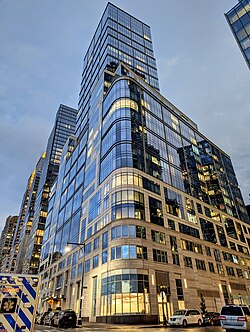
Riverside Drive is a scenic north–south avenue in the New York City borough of Manhattan. The road runs on the west side of Upper Manhattan, generally paralleling the Hudson River and Riverside Park between 72nd Street and the vicinity of the George Washington Bridge at 181st Street. North of 96th Street, Riverside Drive is a wide divided boulevard. At several locations, a serpentine service road diverges from the main road, providing access to the residential buildings. The avenue was opened in 1880, and several viaducts were completed over the subsequent decades to connect the various segments of Riverside Drive.

The Joe DiMaggio Highway, commonly called the West Side Highway and formerly the Miller Highway, is a 5.42-mile-long (8.72 km) mostly surface section of New York State Route 9A (NY 9A), running from West 72nd Street along the Hudson River to the southern tip of Manhattan in New York City. It replaced the West Side Elevated Highway, built between 1929 and 1951, which was shut down in 1973 due to neglect and lack of maintenance, and was dismantled by 1989. North of 72nd Street the roadway continues north as the Henry Hudson Parkway.

Riverside South is an urban development project in the Lincoln Square neighborhood of the Upper West Side of Manhattan, New York City. It was originated by six civic associations – The Municipal Art Society, Natural Resources Defense Council, New Yorkers for Parks, Regional Plan Association, Riverside Park Fund, and Westpride – in partnership with real estate developer Donald Trump. The largely residential complex, located on the site of a former New York Central Railroad yard, includes Freedom Place and Riverside Center. The $3 billion project is on 57 acres (23 ha) of land along the Hudson River between 59th Street and 72nd Street.

Hudson Yards is a neighborhood on the West Side of Midtown Manhattan in New York City, bounded roughly by 30th Street in the south, 41st Street in the north, the West Side Highway in the west, and Eighth Avenue in the east. The area is the site of a large-scale redevelopment program that is being planned, funded, and constructed under a set of agreements among the State of New York, City of New York, and Metropolitan Transportation Authority (MTA), with the aim of expanding the Midtown Manhattan business district westward to the Hudson River. The program includes a major rezoning of the Far West Side, an extension of the New York City Subway's 7 and <7> trains to a new subway station at 34th Street and 11th Avenue, a renovation and expansion of the Javits Center, and a financing plan to fund the various components. The various components are being planned by New York City Department of City Planning and New York City Economic Development Corporation.
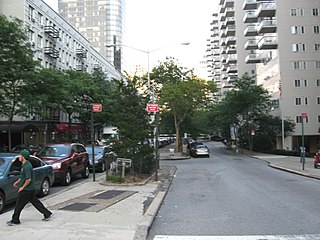
66th Street is a crosstown street in the New York City borough of Manhattan with portions on the Upper East Side and Upper West Side connected across Central Park via the 66th Street transverse. West 66th Street is notable for hosting the Lincoln Center for the Performing Arts between Broadway and Columbus Avenue.

96th Street is a major two-way street on the Upper East Side and Upper West Side sections of the New York City borough of Manhattan. It runs in two major sections: between the FDR Drive and Fifth Avenue on the Upper East Side, and between Central Park West and Henry Hudson Parkway on the Upper West Side. The two segments are connected by the 97th Street transverse across Central Park, which links the disconnected segments of 96th and 97th Streets on each side.

The Apthorp is a condominium building at 2211 Broadway on the Upper West Side of Manhattan in New York City, United States. The 12-story structure was designed by Clinton & Russell in the Italian Renaissance Revival style and occupies the full block between Broadway, West End Avenue, and West 78th and 79th Streets. It was built between 1905 and 1908 as a residential hotel by William Waldorf Astor, who named it after the Apthorp Farm, of which the site used to be part. The Apthorp is a New York City designated landmark and is listed on the National Register of Historic Places.

One57, formerly known as Carnegie 57, is a 75-story, 1,005 ft (306 m) supertall skyscraper at 157 West 57th Street between Sixth and Seventh Avenues in the Midtown neighborhood of Manhattan in New York City. The building has 92 condominium units above a 210-room Park Hyatt Hotel that serves as the flagship Hyatt property. The tower was developed by Extell Development Company and designed by Christian de Portzamparc. It was the first ultra-luxury condominium tower along a stretch of 57th Street called Billionaires' Row.
Gary Barnett is an American businessman. He is the president and founder of Extell Development Company, a real estate development firm involved in residential, commercial and hospitality properties, including several high-profile buildings in Manhattan, New York.
Extell Development Company is an American real estate developer of residential, commercial, retail, hospitality, and mixed-use properties. Founded in 1989 by Gary Barnett, the company’s portfolio exceeds 20 million square feet. The company has between 125 and 150 employees. Prior to 2005, it was known as Intell Management and Investment.

Hudson Park and Boulevard is a greenway and boulevard in Hell's Kitchen, Manhattan in New York City, being built as part of the Hudson Yards Redevelopment Project. It lies between 10th and 11th Avenues. The park, officially called Bella Abzug Park, is located in the median of the boulevard, which consists of two one-way roads that run parallel to each other.

55 Hudson Yards is a skyscraper in Hudson Yards, Manhattan, New York City, just outside the Hudson Yards Redevelopment Project. It and 50 Hudson Yards will add a combined 4 million square feet (370,000 m2) of space to the Hudson Yards project, even though the two buildings are located outside the redevelopment site itself.
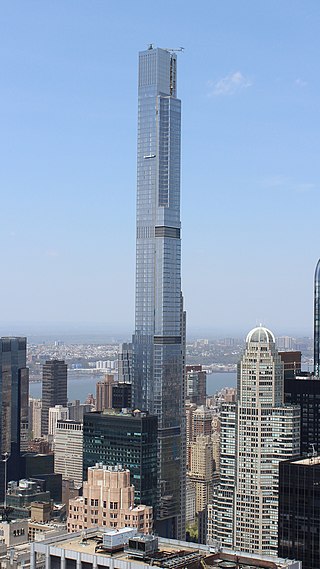
Central Park Tower is a residential supertall skyscraper at 225 West 57th Street, along Billionaires' Row, in the Midtown Manhattan neighborhood of New York City, New York, U.S. Designed by Adrian Smith + Gordon Gill Architecture, the building rises 1,550 feet (472.4 m) with 98 above-ground stories and three basement stories, although the top story is numbered 136. Central Park Tower is the second-tallest building in New York City, the United States, and the Western Hemisphere; the 15th tallest building in the world; the tallest primarily residential building in the world; and the tallest building outside Asia by roof height.

A "poor door" is a separate entrance to a multi-unit housing development for those living in less expensive apartments.

220 Central Park South is a residential skyscraper in Midtown Manhattan in New York City, situated along Billionaires' Row on the south side of Central Park South between Broadway and Seventh Avenue. 220 Central Park South was designed by Robert A.M. Stern Architects and SLCE Architects, with interiors designed by Thierry Despont. It is composed of two sections: a 70-story, 950-foot (290 m) tower on 58th Street, which is the 21st-tallest building in New York City, as well as an 18-story section on Central Park South, both of which contain a limestone facade. Most of the 118 apartments are duplex apartments, although some of the units have been combined to create larger units. The building has a porte-cochère, a wine cellar, private dining rooms, and various recreational facilities.
Hill West Architects is a New York City based architecture firm which works on the planning and design of high-rise residential and hospitality buildings, retail structures and multi-use complexes. They have participated in the design of prominent structures in the New York City metropolitan area. The firm was founded in 2009 by Alan Goldstein, L. Stephen Hill and David West.
Kevin P. Maloney is an American real estate developer and founder of Property Markets Group.
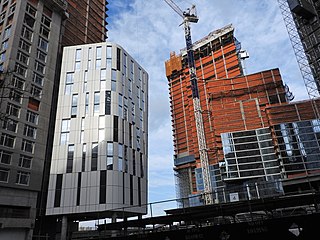
Waterline Square is a 5-acre (2.0 ha), $2.3 billion luxury condominium and rental development near the Hudson River on the Upper West Side of Manhattan in New York City. The complex includes three residential towers with 1,132 units and 3 acres (1.2 ha) of park, along with 100,000 square feet (9,300 m2) of amenity space. The residences range in size from one to five bedrooms.

HFZ Capital Group is a real estate development and investment company based in New York City. Ziel Feldman founded HFZ in 2005 and is chairman. As of 2019, HFZ managed more than $10 billion worth of development.
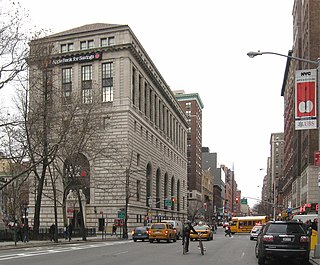
The Apple Bank Building, also known as the Central Savings Bank Building and 2100 Broadway, is a bank and residential building at 2100–2114 Broadway on the Upper West Side of Manhattan in New York City. Constructed as a branch of the Central Savings Bank, now Apple Bank, from 1926 to 1928, it occupies a trapezoidal city block bounded by 73rd Street to the south, Amsterdam Avenue to the east, 74th Street to the north, and Broadway to the west. The Apple Bank Building was designed by York and Sawyer in the Renaissance Revival and palazzo styles, patterned after an Italian Renaissance-style palazzo.
